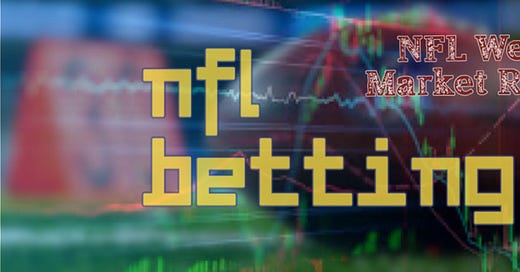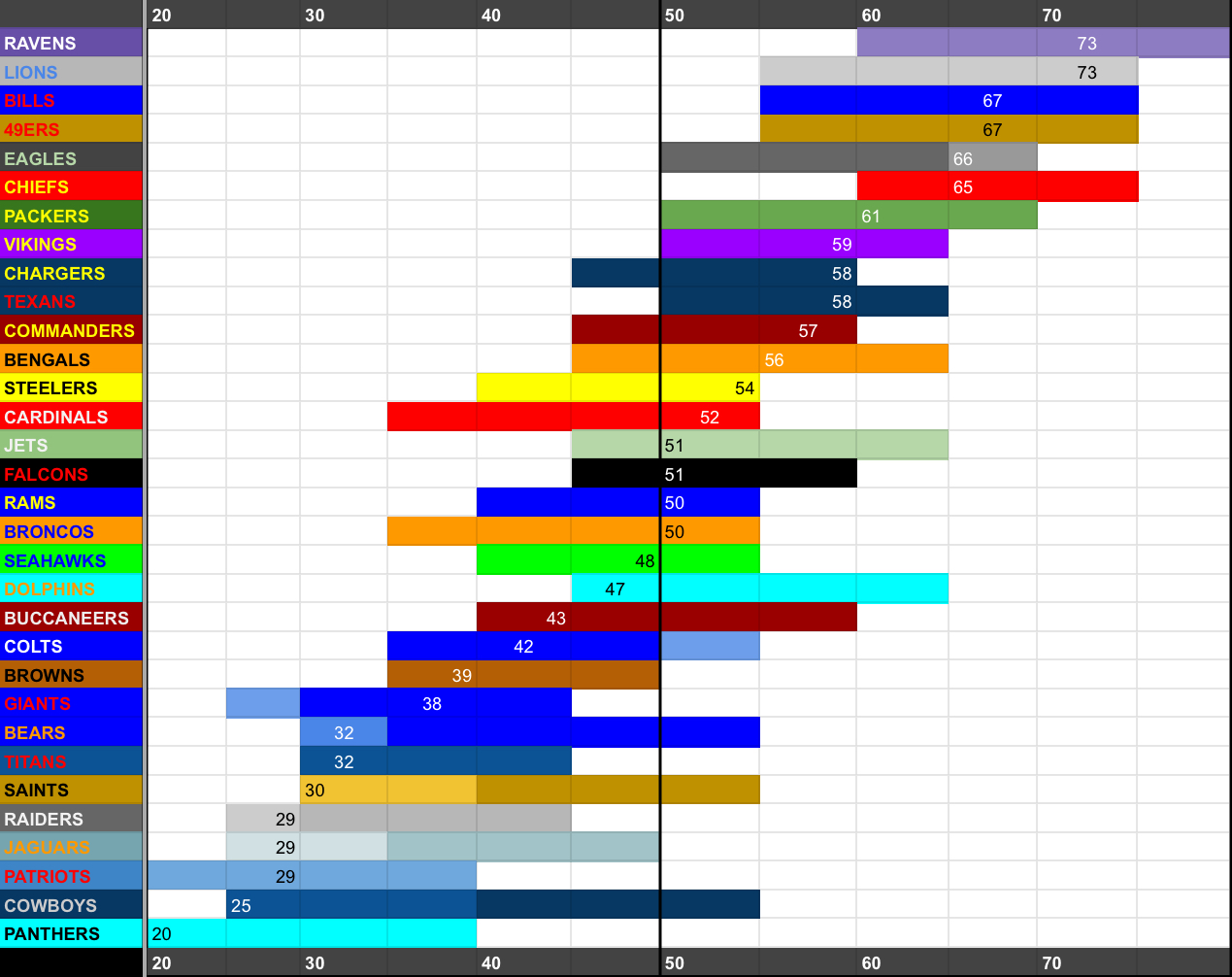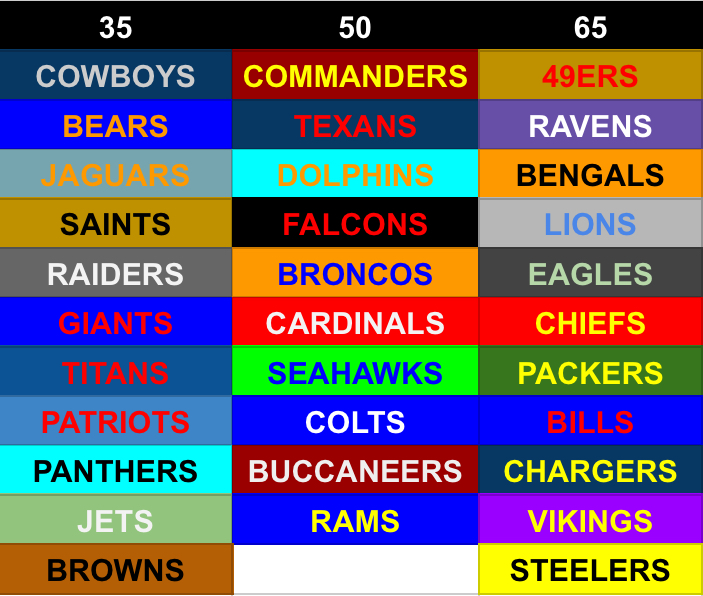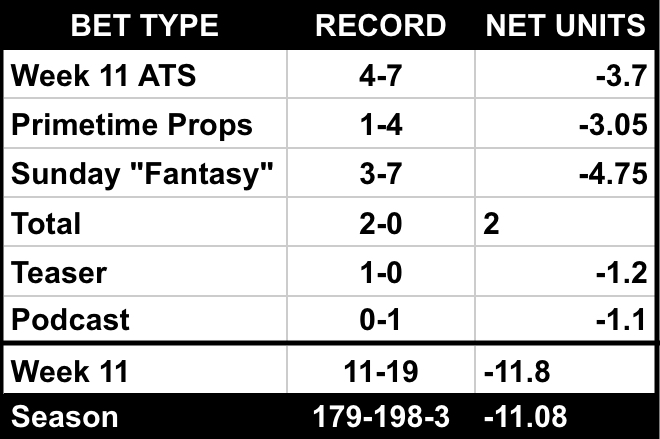NFL Week 11 Market Report
Putting a wrap on the betting market’s power ratings before the holiday season
Matt Russell is the creator of THE WINDOW, and former lead betting analyst at theScore. If there’s a bad beat to be had, Matt will find it. You can find him @mrussauthentic on X.
It’s the last market report of the season! How time flies.
Every team’s played at least 10 games, and at this point, we have a firm understanding of how the market views each team, and we can be confident in, at minimum, putting them in tiers.
It takes a while to move up, as we’ve seen with the Vikings, Commanders, Steelers, and Broncos. Meanwhile, it doesn’t take much to get downgraded. One bad performance and “this team sucks” becomes the widely held view (unless it’s the Jets, who get all the leeway in the world, apparently).
You now know what happens when a team’s starting quarterback gets hurt, and how it affects the line. You know that very few non-quarterbacks inspire a change to a team’s rating, and overreacting to news is a bad idea.
In this season finale of the market power ratings, we’ll touch on every franchise, noting where they started the season, referencing their Week 1 power rating, with that number in brackets.
For a breakdown of Week 11 and all the betting takeaways, check out the Tuesday episode of THE WINDOW: Sports betting podcastEstimated market ratings
Before the season, we explained the process of how the betting market takes the first odds offered from sportsbooks about a team’s quality - regular season win (RSW) totals - and translates that into a team rating.
Each game provides a subsequent data point that we receive from oddsmakers and bettors alike - the closing line (the last available point spread to bet before kickoff).
Taking the most recent game’s closing line into account, we adjust every team’s market rating to reflect where they were relative to the rest of the league before the previous week’s games.
These are not power rankings - a largely pointless exercise done for clicks - that simply list each team in a made-up order for readers to argue about.
They are ratings, which allow for the possibility that teams can be perceived to be equal - or have a large gap - amongst the other 31 teams in the NFL. To better understand the chart above, refer back to Week 1’s market rating column. You can argue about them, OR you can just bet against them.
The Ravens (66) quickly moved up into the No. 1 power rating spot in the betting market, and while they’re still up there with the Lions (65) - who’ve covered all but two games - now pressing them, Baltimore’s 1-3 against the spread in their last four games, and their record has them sitting at tied for ninth in the NFL. The Steelers (48) beat Baltimore as a home underdog - befitting a team with just two losses (straight up and against the spread), that the market just can’t fully commit to.
Somewhat fascinatingly, the Chiefs (69) came into the season rated the highest, won all their games until Week 11 and somehow fell in market power ratings. Even before losing in Buffalo (58), Kansas City were being called “not as good as their record” and a loss felt inevitable. The Bills’ win wasn’t uncommon, given it came in the regular season, but as the favorite they were already getting considerably more credit than in the offseason when they were rated on the level of the Dolphins (57) and Jets (57).
Miami’s not back there, as they’ve been underwhelming even with the return of Tua Tagovailoa, while the Jets are one of few teams making the case for this column to keep going for the last few weeks of the season, since we haven’t seen how low they can go.
You might have forgotten that there was concern about the 49ers (65) even before the season. At least compared to where they were as the top-rated team for much of 2023. With an opening season cover over the Jets (that doesn’t look nearly as impressive as it did at the time), and just two more covers throughout the season, they’ve had just enough excuses for a 5-5 record that the market hasn’t gone full-sell just yet, but maybe this week’s loss to the Seahawks (47) will be enough to trigger one.
The Eagles (63) have been on their own ride. Philadelphia outlasted the Commanders on a short week, taking enough money to have them close -4.5 - pushing through the ceiling for what we were comfortable rating them on average. But given their preseason rating was in the low-60s, maybe that limitation wasn’t fair?
Out of their bye, the Packers (57) weren’t able to perform up to the highest rating the market had assigned for them this season. In hindsight, it was a textbook case of sell-high in conjunction with the Bears’ (49) being rated at their lowest all season.
Only five teams were rated worse than the Vikings (40) before the season, so while their play has leveled off, settling in around 60/100 is a pretty good result and with a cover on the road against the Titans (41) last week, we can be confident with where Minnesota sits in the hierarchy.
The Commanders (36) took an extra week or two to get going, but they’ve been trailing the Vikes’ road up the ratings. Washington is a Hail Mary and escaping a mediocre performance against the Giants away from having not covered in four straight, so their current rating is less certain than Minnesota’s.
If you ask the mainstream media talking heads, the Chargers (48) exorcised some “Chargering” demons in one game against the Bengals (56), but it’s possible that Cincinnati’s inability to win the close games had more to do with it. Another primetime test is forthcoming in L.A.
The Texans (62) have only moved down a little in the grand scheme of things, but the eye test has left something lacking. Catching the Cowboys (57) at the right time went a long way towards Monday’s result.
The Cardinals (42) didn’t play last week, allowing for everyone to digest that they’re leading the NFC West, and are being considered an above-average team. Even though they were just home ‘dogs to the Jets.
The Rams (46) covered on the road against the Patriots (34), again resting on the connection between Matthew Stafford and Puka Nacua/Cooper Kupp. New England played well though, and are a team that should find their way to, and through, their preseason rating as long as Drake Maye is still playing.
Elsewhere in the middle-of-the-pack, the Broncos (33) have gone from tied with the Panthers (33) at the bottom of the league before the season, to being favored and crushing the Falcons (57), who couldn’t be more “mid” if they tried, and are leaving the door ajar in the NFC South.
Which means it’s a strangely important game for the Buccaneers (46) as they take on the Giants (36). Two teams that aren’t rated far from their preseason perception come out of their bye week to meet in the Meadowlands. Tampa has every reason to play up their top-end rating, while Tommy DeVito takes over for New York, and who knows what that means for their level of play this Sunday and beyond.
The Colts (46) pulled out a win in the same stadium last week, as their week-to-week play has them toggling between the middle and bottom tier. The Browns (56) are similarly bi-polar, choosing to fall to the left of our graph above in a loss to the Saints (41), who the market hasn’t had a clue what to do with since an explosive first two weeks had them rated higher than the Eagles, only to have injury-related chaos ensue.
The Jaguars (52) weren’t supposed to be among the dregs of NFL society, but here they are, worse than one could have ever imagined going into their bye week.
Meanwhile, it wouldn’t have taken much imagination to think the Raiders (42) might be in the NFL’s bottom tier, but they have cashed tickets for their bettors in four games, including the Ravens, Chiefs and Rams, proving that no matter how bad it might be on the field, you can still surpass a low bar the market has set for you if the opponent’s getting too much credit.
The 3-tier system
While our chart above shows a gradual progression from worst in the league to first, this season feels more like there’s actually three tiers - good, average and bad.
Going into last week, we remained uncommitted on three teams. We want to see more from the Steelers, and we got it. We wanted to see less from the Browns and Jets, and we got that too. Pittsburgh moves into “good,” while Cleveland and New York slide into the left “bad” column.
As was head into the home stretch, here’s how those tiers might look, in no particular order:








